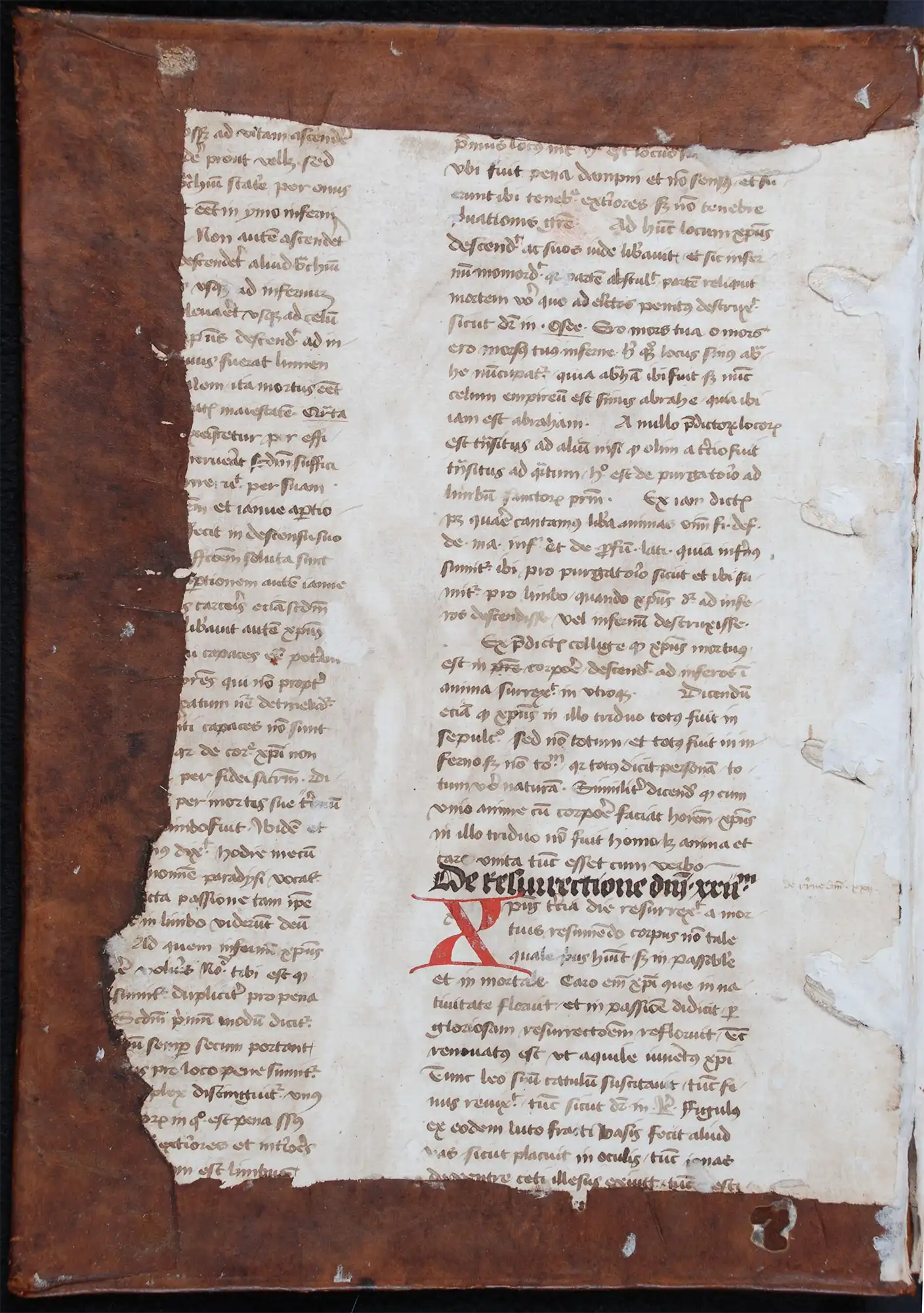Case 1
- Leather bindings of Handpress Era

Jacobus de Voragine. Legenda aurea sanctorum, sive Lombardica historia. Cologne: Conrad Winters, 1476.
Before the introduction of mechanisation to book production in the early nineteenth century, all bookbindings, however simple or elaborate, were individually hand-produced, essentially unique objects. From the beginning of the handpress era in the mid-fifteenth century, most covering materials used on permanent bindings were derived from animal skins, including calfskin, sheepskin, goatskin and vellum. The first three of these are tanned leathers, made by treating the gelatinous central layer of animal skin with tannic acid, derived from trees and plants.
This copy of a 1476 Latin edition of The Golden Legend is bound in seventeenth century calfskin with blind fillets on both boards and gold tooling on the spine. The book’s provenance is resoundingly Scottish – the antiquary Sir James Balfour (ca. 1603-1657) being among its former owners.
The binding contains fragments of mid-fifteenth century Latin manuscript waste recycled as packing beneath the seventeenth century pastedowns - a common practice in early bookbinding.

Jacobus de Voragine. Legenda aurea sanctorum, sive Lombardica historia. Cologne: Conrad Winters, 1476.
Open image in new window

Jacobus de Voragine. Legenda aurea sanctorum, sive Lombardica historia. Cologne: Conrad Winters, 1476.
Before the introduction of mechanisation to book production in the early nineteenth century, all bookbindings, however simple or elaborate, were individually hand-produced, essentially unique objects. From the beginning of the handpress era in the mid-fifteenth century, most covering materials used on permanent bindings were derived from animal skins, including calfskin, sheepskin, goatskin and vellum. The first three of these are tanned leathers, made by treating the gelatinous central layer of animal skin with tannic acid, derived from trees and plants.
This copy of a 1476 Latin edition of The Golden Legend is bound in seventeenth century calfskin with blind fillets on both boards and gold tooling on the spine. The book’s provenance is resoundingly Scottish – the antiquary Sir James Balfour (ca. 1603-1657) being among its former owners.
The binding contains fragments of mid-fifteenth century Latin manuscript waste recycled as packing beneath the seventeenth century pastedowns - a common practice in early bookbinding.

Jacobus de Voragine. Legenda aurea sanctorum, sive Lombardica historia. Cologne: Conrad Winters, 1476.
Open image in new window
![[Book of Hours, French and Latin]. Northern France, ca. 1500.](https://www.reedgallery.co.nz/__data/assets/image/0017/601118/1b.webp)
[Book of Hours, French and Latin]. Northern France, ca. 1500.
This manuscript Book of Hours (Reed MS8) is bound in late sixteenth century brown calf gilt, with a small plaque of the symbols of the Passion stamped on the sides. The upper joint has been repaired.
Gold tooling came to Europe via the middle-east in the late fifteenth century, spreading to England by the first quarter of the sixteenth century.
![[Book of Hours, Latin]. Paris: Jehan de la Roche, 1514.](https://www.reedgallery.co.nz/__data/assets/image/0018/601119/1c.webp)
[Book of Hours, Latin]. Paris: Jehan de la Roche, 1514.
This Book of Hours, printed on vellum, is bound in sixteenth century brown calf (restored) with arabesque borders and centrepiece stamped in gilt on both boards; spine gilt-stamped.
![[Manual, Latin]. [Venice?, 1574].](https://www.reedgallery.co.nz/__data/assets/image/0010/601120/1d.webp)
[Manual, Latin]. [Venice?, 1574].
This Latin manuscript from Italy signed by the scribe Johannes Vitalis (Reed MS9) is bound in sixteenth century gold-tooled red morocco stamped on the back board with the initials S.M.V. (San Marco, Venezia?).
![[Manual, Latin]. [Venice?, 1574].](https://www.reedgallery.co.nz/__data/assets/image/0011/601121/1dd.webp)
[Manual, Latin]. [Venice?, 1574].
This Latin manuscript from Italy signed by the scribe Johannes Vitalis (Reed MS9) is bound in sixteenth century gold-tooled red morocco stamped on the back board with the initials S.M.V. (San Marco, Venezia?).


![[Book of Hours, French and Latin]. Northern France, ca. 1500.](https://www.reedgallery.co.nz/__data/assets/image/0017/601118/1b.webp)
![[Book of Hours, Latin]. Paris: Jehan de la Roche, 1514.](https://www.reedgallery.co.nz/__data/assets/image/0018/601119/1c.webp)
![[Manual, Latin]. [Venice?, 1574].](https://www.reedgallery.co.nz/__data/assets/image/0010/601120/1d.webp)
![[Manual, Latin]. [Venice?, 1574].](https://www.reedgallery.co.nz/__data/assets/image/0011/601121/1dd.webp)